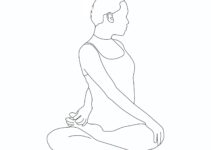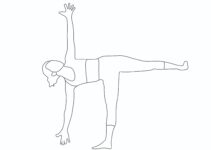Utthita Parsvakonasana outline
Utthita Parsvakonasana is comprised of four words:
- Utthita means ‘extended’
- Parsva means ‘side or flank.’
- Kona means ‘angle’
- Asana means ‘yoga pose’.
It is pronounced as oo-TEE-Utah parish-vah-cone-AHS-anna
Based on its analysis, it is also known as the Extended Side Angle Pose. The yoga pose affects the many parts of the body, viz. legs, ankles, groin, chest, lungs, shoulders, spine, and abdomen. Hence, in the modern perspective, it is known as a current yoga exercise.

How to do Utthita Parsvakonasana step-by-step
- Turn the right foot to the right at 90 degrees and the left at 60 degrees to the right side while keeping the left leg stretched out.
- Come to the Tadasana.
- Inhale and make a gap of one meter between your legs as per your convenience.
- Raise the arms sideways at the shoulder level.
- Bend the right leg at the knee forming a right angle with the thigh and the calf with the right thigh parallel to the floor.
- Exhale and bend from the waist to the right side and bring the right arm down so that the right armpit touches the inner side of the right knee and the right side of the upper trunk touches the right thigh.
- Place the right palm on the floor by the inner side of the right foot.
- In the final posture, the spine must be kept straight and the left foot flat on the floor.
- Hold the posture for 30 seconds, breathing normally.
- Inhale and lift the right palm from the floor, raise the trunk, straighten the right leg, raise the arms and come back to the starting position.
- Repeat it from the other side with the same procedure.
Top 10 benefits of Utthita Parsvakonasana
- Weight loss: It gives adequate stretch from fingers to toes. Maintaining the pose for a certain period, along with the regular practice of it, helps to burn fats from the body and is good if you want natural weight loss and well-being.
- Heart health: The yoga pose is good for the heart’s health as it provides adequate massage and stretches to the heart muscles.
- Improves digestion: It helps to release gastric juices by facilitating proper stretch to the abdominal muscles.
- Slim waist and hips: The adequate stretch at the waist and hips region helps to shed unnecessary fats of these regions.
- Legs strengthening: If you have leg problems, viz. weak muscles, knee pain, alignment, etc., you should perform it for better results.
- Stamina: It helps to increase overall stamina.
- Lung expansion: Stretching nearby lungs while practising the pose is extremely helpful in expanding the lungs region and lung capacity.
- Knee pain: It is also good to overcome knee pain.
- Spine-health: It is one of the rare yoga poses which provides adequate stretching to the spine and provides the best health to the spinal region.
- Infertility: The practice of the pose with proper technique and regularity also helps treat infertility.
Utthita Parsvakonasana contraindications
- It shouldn’t be performed during high or low blood pressure.
- Headache
- Migraines
- Insomnia
- Cervical spondylosis
- Neck injury
- Groin injury
Therapeutic benefits of Utthita Parsvakonasana
- Cardiac relaxation.
- Cholesterol burning
- Constipation
- Sciatica
- Osteoporosis
- Infertility
- Back pain
- Menstruation
- Ankle health
Preparatory poses
- Tadasana
- Triangle pose
- Garudasana
- Vrikshkasana
- Virabhadrasana
Follow up poses
- Tadasana
- Padmasana
- Shavasana
Utthita Parsvakonasana variations
- Ardha Baddha Utthita Parsvakonasana
- Baddha Utthita Parsvakonasana
- Parivritta Parsvakonasana
Utthita Parsvakonasana’s common mistakes
- The knee shouldn’t be ahead of the ankle; the lung should be aligned with your heel.
- The knee shouldn’t be turning inward. The toes and knee should be aligned.
- Leaning on the arm is not a good option. Try to put your weight on your legs.
- Heel off the ground: The heels should be on the ground.
- Chest shouldn’t be turned towards the floor.





